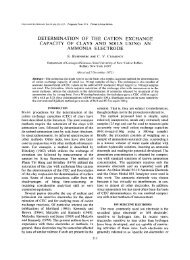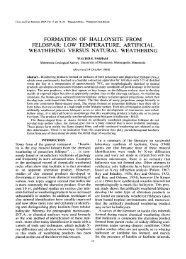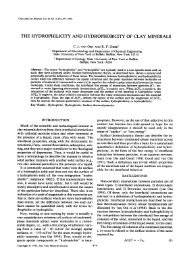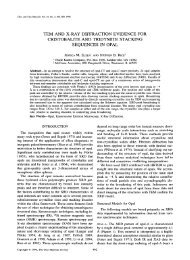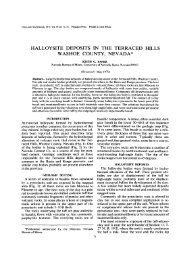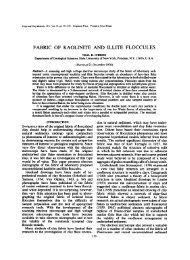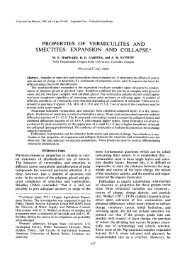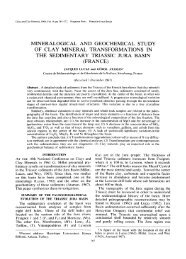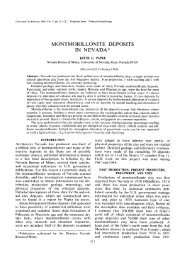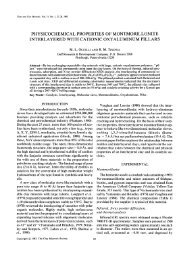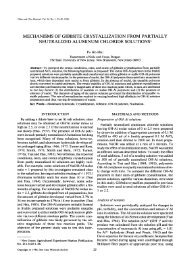FREEZE-DRIED AND THAWED CLAYS - Clay Minerals Society
FREEZE-DRIED AND THAWED CLAYS - Clay Minerals Society
FREEZE-DRIED AND THAWED CLAYS - Clay Minerals Society
You also want an ePaper? Increase the reach of your titles
YUMPU automatically turns print PDFs into web optimized ePapers that Google loves.
<strong>Clay</strong>sand<strong>Clay</strong><strong>Minerals</strong>, 1971,Vol, 19,pp. 103-107. Pergamon Press. Printed in Great Brilain<br />
<strong>FREEZE</strong>-<strong>DRIED</strong> <strong>AND</strong> <strong>THAWED</strong> <strong>CLAYS</strong><br />
JAMES LINCOLN* and RODNEY TETTENHORST<br />
Department of Mineralogy, The Ohio State University, Columbus, Ohio 43210<br />
(Received 9 July 1970)<br />
Abstract-Heating montmorillonites to their dehydroxylation temperatures destroyed their ability<br />
to form an aerogel. The breakdown of the aerogel structure coincided with the loss of hydroxyl water<br />
from the montmorillonite. Apparently, this loss of water was accompanied by a loss of the layer<br />
charge. Particle size and aerogel-forming ability appear to be inversely related properties for at least<br />
some montmorillonites. The kaolinite investigated did not form an aerogel in any size fraction. The<br />
formation of montmorillonite aerogels from various concentrations of clay was investigated. The<br />
texture and physical appearance of these aerogels was examined and presented herein.<br />
Thawed clay suspensions exhibited a variety of behaviors. The Volclay bentonite, which apparently<br />
formed a true sol was unaffected by freezing. In all other clays at least some of the fine clay<br />
particles agglomerated on freezing and large clumps were observed dropping out of the melting ice.<br />
After stirring the thawed suspensions less clay was dispersed than in the unfrozen suspension counterparts.<br />
Addition of a dispersing agent to these suspensions caused more clay to remain dispersed<br />
following freezing-thawing-stirring.<br />
INTRODUCTION<br />
<strong>FREEZE</strong>-dried clays have been prepared by several<br />
investigators, e.g. Call, 1953; Ahlrichs and White,<br />
1962; and van Olphen, 1967. Ahlrichs and White<br />
gave X-ray diffraction data for freeze-dried clays<br />
and provided some photomicrographs. Norrish<br />
and Rausell-Colom (1962) and Anderson and<br />
Hoekstra (1965) also investigated the X-ray<br />
diffraction characteristics of frozen and thawed<br />
clays.<br />
We have investigated the effect of pre-heating<br />
and particle size of clay minerals with respect to<br />
their aerogel-forming ability in order to determine<br />
some of the factors that may influence the formation<br />
of an aerogel from a clay-water system. During<br />
the course of this investigation some phenomena<br />
were observed concerning the presence or absence<br />
of aerogels after freeze-drying clay sols and suspensions.<br />
In addition the agglomeration of clay<br />
particles upon thawing was observed for different<br />
clay species.<br />
The terminology in this study referring to colloidal<br />
phenomena are taken from van Olphen (1963).<br />
MATERIALS<br />
The clay minerals investigated were a Wyoming<br />
bentonite (Volclay) obtained from the American<br />
Colloid Company, a montmorillonite from Otay,<br />
California and hectorite from Hector, California<br />
*Present address: Center for Aquatic Biology, Eastern<br />
Michigan University, Ypsilanti, Mich. 48197.<br />
103<br />
both obtained from Ward's Natural Science Establishment<br />
and a kaolinite obtained from the Edgar<br />
<strong>Minerals</strong> Corporation.<br />
EXPERIMENTAL PROCEDURES<br />
All clays were separ~ated into three size fractions,<br />
-44/x, -2g. and-0.2/x. The-44/x fraction was<br />
obtained by dry screening, the --2g. fraction was<br />
obtained by settling in distilled-demineralized<br />
water and the -0-2/z fraction was obtained by<br />
means of a supercentrifuge. The concentration<br />
of the clay suspensions was set at 0.25 wt. % clay<br />
for all size fractions (except where noted). The<br />
Otay and Hector samples required hand grinding<br />
prior to dispersal in water. No dispersing agent or<br />
other treatment was used to obtain any size fraction.<br />
Freeze-drying was performed on a VirTis<br />
apparatus.<br />
Portions of the --44/~ fraction of three clays<br />
(Volclay, Otay, and Edgar) were fired at 250~<br />
450~ 650~ 850~ and 1050~ for 12 hr. The<br />
heated powders were remixed with distilled<br />
water in a Waring blender to a 0-25 wt. % concentration<br />
and the suspensions sprayed into ultra<br />
cold pentane and freeze-dried by a method outlined<br />
by Lincoln, Miller and Tettenhorst (1970).<br />
Separate portions of the three size fractions of<br />
each clay were also prepared and freeze-dried<br />
in this manner.<br />
A method was used to determine apparent density<br />
which gave consistent relative data but did<br />
not guarantee absolute results. A given volume<br />
of sample was weighed in either a graduated cylin-
104 J. LINCOLN and R. TETTENHORST<br />
der or a calibrated glass tube. The samples were<br />
loaded with a spatula and tapped down against<br />
a table to provide the proper volume. An average<br />
value of apparent density was determined from<br />
three measurements on each sample (Tables 1<br />
and 2),<br />
Table 1. Apparent densities of freeze-dried<br />
Volclay montmorillonite, Otay montmorillonite<br />
and Edgar kaolinite after firing at<br />
different temperatures. Particle size was<br />
< 44/x<br />
Apparent density in gm/cm 3<br />
Temp. Volclay Otay Edgar<br />
(~<br />
N.H.* 0.006 0.037 0.115<br />
250 0.005 0"039 0"101<br />
450 0.006 0.082 0" 118<br />
650 0.287 0'253 0-135<br />
850 0.334 0.405 0" 146<br />
1050 0.319 0"425 0-206<br />
*N.H. refers to non-heated portions of<br />
each clay.<br />
Table 2. Apparent densities of<br />
freeze-dried Volclay montmorillonite.<br />
Otay montmorillonite and<br />
Edgar kaolinite for different particIe<br />
sizes<br />
Apparent density in gm/cm 2<br />
(/z) Volclay Otay Edgar<br />
< 44 0.006 0.037 0-115<br />
< 2.0 0-004 0-020 0.032<br />
< 0.2 0-003 0.004 0-014<br />
<strong>FREEZE</strong>-<strong>DRIED</strong> <strong>CLAYS</strong><br />
Volclay and Otay montmorillonites and Edgar<br />
kaolinite samples were freeze-dried under various<br />
conditions of temperature and particle size. In<br />
addition Volclay was freeze-dried in beakers at<br />
different concentrations and the resulting aerogels<br />
described.<br />
Heating<br />
Apparent density determinations were made on<br />
the freeze-dried clays to provide some measure<br />
of their aerogelforming ability prior to heating and<br />
after heating to successively higher temperatures.<br />
All of the Otay montmorillonite and Edgar kaolinite<br />
freeze-dried samples crumbled to a powder<br />
upon sublimation and gave relatively high apparent<br />
densities (Table 1). The increase in apparent<br />
densities of the samples heated to relatively high<br />
temperatures probably reflects their inability to<br />
be dispersed following heat treatment (Table 1).<br />
An aerogel structure formed in the non-heated<br />
Volclay montmorillonite and those Volclay samples<br />
heated to low temperatures. Loss of aerogelforming<br />
ability appears to occur with a loss of<br />
structural water, i.e. upon dehydroxylation.<br />
Particle size<br />
Particle size seemed to be related to aerogelforming<br />
ability of the montmorillonites studied and<br />
the apparent density of Otay montmorillonite and<br />
Edgar kaolinite (Table 2). The apparent density of<br />
the normally non-aerogel-forming Otay montmorillonite<br />
decreased with a decrease in particle size.<br />
The --0.2tz fraction formed a fluffy structure that<br />
resemNed loosely packed snowflakes very similar<br />
to the Volclay montmorillonite. No volume loss<br />
was observed in the --0.2/z freeze-dried fraction<br />
of Otay. The - 2/~ Otay sample formed a granular<br />
mass whose character seemed intermediate between<br />
the high density non-aerogel powders and<br />
the low density fluffy aerogels. The -2tz Volclay<br />
and Otay samples are pictured in Fig. 1 to show<br />
their appearance and relative volumes for a given<br />
weight of clay.<br />
The apparent density of Edgar kaolinite also<br />
decreased with a decrease in particle size but the<br />
freeze-dried -0.2/, fraction could hardly be<br />
termed an aerogel since the volume loss on freezedrying<br />
was about 90 per cent. Volclay experienced<br />
a very small volume loss in the --44/z fraction and<br />
no volume loss in the two smaller fractions. The<br />
apparent density was little affected by the different<br />
size fractions.<br />
In aqueous suspensions, gels form at lower<br />
concentrations with smaller particle sizes (van<br />
Olphen, 1967). This condition could likely be<br />
applied to aerogels also if the same type forces<br />
(net edge and face charges) produce the structure.<br />
It would appear then that Volclay has a greater<br />
percentage of small particles than does Otay<br />
due to the fact that Volclay forms an aerogel at all<br />
tbe three size fractions investigated and Otay at<br />
only the smallest. Roberson, Weir, and Woods<br />
(1968) have shown that only I0 per cent by weight<br />
of Volclay particles are greater than 1.0/x equivalent<br />
spherical diameter. However, these data<br />
do not quantitatively consider the results of particle<br />
agglomeration.<br />
<strong>Clay</strong> concentration<br />
The effect of clay concentration on the resulting<br />
aerogel structure was investigated in a separate<br />
experiment. A one per cent suspension of Volclay<br />
montmorillonite whose particle size was -2tz<br />
was prepared and compared with a 0.25 per cent
Fig. 1. Photomicrograph of thin section of shale No. l, crossed polars. Lighest areas mainly<br />
represent highly birefringent calcite. Some quartz grains are clear, whereas others are dark<br />
at extinction positions, Approximately one-third of this rock section is calcite. Some opaque<br />
spots are partially oxidized pyrite.<br />
Fig. 2. Photomicrograph of thin section No. 2. crossed polars. Quartz silt shows as bright,<br />
bireflingent spots, All birefringent calcite, as seen in No, 1, has been removed. The dark<br />
background ~epresents dark iron-o• and low-t~i~efringent clay mineral {kaolinite and<br />
illite), Bar length represents 0.25 mm.
<strong>FREEZE</strong>-<strong>DRIED</strong> <strong>AND</strong> <strong>THAWED</strong> <strong>CLAYS</strong> 105<br />
Volclay suspension having the same particle size.<br />
200 ml of both samples were placed in a refrigerator<br />
freezer and subsequently placed in the freezedrying<br />
unit. The one per cent clay sample formed<br />
an aerogel and maintained its original volume after<br />
freeze-drying. The 0-25per cent clay sample<br />
formed a structure that resembled a spider's web<br />
which could not be termed an aerogel as it collapsed<br />
after freeze-drying because the framework<br />
was too delicate to support its own weight.<br />
Van Olphen (1963) defines aerogel as a dry<br />
framework of solid material which retains some<br />
strength and maintains a constant volume after<br />
freeze-drying a hydrogei. Shrinkage and collapse<br />
of structure is prevented in an aerogel but this does<br />
not establish that the same structure existed in<br />
the hydrogel state (van Olphen, 1967). Sodium<br />
bentonite hydrogels are obtained at clay concentrations<br />
of about 2 per cent by weight or higher<br />
(van Olphen, 1967). The concentrations of clay<br />
in this study that formed aerogels were well below<br />
this figure. Thus, it seems likely from this study<br />
that aerogels can form from bentonite sols and<br />
suspensions as well as hydrogels. This would<br />
suggest that the absence of an aerogel upon freezedrying<br />
was due to insufficient or no layer charges<br />
present on the clay.<br />
A erogel texture<br />
The aerogel formed from the one per cent suspension<br />
appeared as a fibrous mass (Fig. 2);<br />
this feature had previously been noted and photographed<br />
by Ahlrichs and White (1962). An<br />
irregularly lineate structure was observed on the<br />
top of the clay-ice mass after freezing but before<br />
subliming, which indicated the fibers were formed<br />
upon freezing. The fibers were irregular and flat<br />
and resembled loose whitish chrysotile. The length<br />
of the fibers was determined by the depth of the<br />
suspension when frozen as the majority of the fibers<br />
formed perpendicular to the surface of the suspension.<br />
Fibers as large as 189 in. in length were<br />
observed. A quickly frozen sample seemed to<br />
form thinner and more perfect fibers than a slowly<br />
frozen sample.<br />
Electron micrographs were taken of a fiber<br />
obtained from the 1 per cent suspension (Lincoln,<br />
1969). The pictures were similar to those shown by<br />
Jonas and Oliver (1967) for spray-dried montmorillonite.<br />
An electron diffraction pattern of 25<br />
square /x area taken with the electron beam<br />
perpendicular to the fiat surface of the fiber showed<br />
the presence of diffraction rings all of which<br />
were indexed as hk reflections. These data suggested<br />
that the clay particles were oriented with their<br />
basal planes parallel to the fiat fiber surface but<br />
randomly around an axis perpendicular to the fiat<br />
fiber surface. In contrast to the aerogel flakes,<br />
X-ray diffraction patterns (Lincoln, Miller and<br />
Tettenhorst, 1970) indicated that spray-frozen,<br />
freeze-dried Volclay and Otay particles approached<br />
a random arrangement in all directions.<br />
<strong>FREEZE</strong>-<strong>THAWED</strong> <strong>CLAYS</strong><br />
Some observations were made on the behavior<br />
of clay suspensions that were allowed to thaw at<br />
room temperatures following freezing. These<br />
experiments were performed for the most part on<br />
the -2p. fractions of suspensions that contained<br />
less than one percent by weight of clay. The clays<br />
investigated were Volclay and Otay montmorillonites,<br />
Edgar kaolinite, and hectorite. 200ml<br />
of the clay suspensions were frozen in glass beakers<br />
in a refrigerator freezer. All clays but the Volclay<br />
montmorillonite occupied the central portion of the<br />
clay-ice mass upon freezing; clay-free clear ice<br />
was observed on the bottom and the sides of the<br />
beakers. Apparently the first water to freeze<br />
expelled all clay particles except those of Volclay,<br />
which were distributed throughout the frozen<br />
volume.<br />
Upon thawing all of the clays except the Volclay<br />
montmorillonite came out of the thawing ice mass<br />
in clumps. The aggregation of the fine clay particles<br />
caused the clay to settle immediately upon<br />
being released from the ice. After the ice had<br />
completely melted the hectorite and Otay clays<br />
were on the beaker bottom, while some of the<br />
Edgar kaolinite remained in suspension. The<br />
aggregation of the clay particles into clumps<br />
probably occurred on freezing.<br />
The Volclay montmorillonite apparently formed<br />
a true sol prior to freezing. This material did not<br />
come out of the ice in clumps but formed an apparent<br />
gel on thawing with the clay occupying<br />
89 the original suspension volume. The clay was<br />
easily returned to its original sol state by gentle<br />
swirling. Refreezing and thawing the Volclay sol<br />
several times caused no apparent change in state.<br />
Additions of sodium metaphosphate also caused no<br />
change in the behavior of the Volclay sample.<br />
Gentle stirring of the thawed suspensions of<br />
Edgar kaolinite, Otay montmorillonite, and hectorite<br />
caused more of each of these clays to be<br />
dispersed when observed 24 hr after stirring. The<br />
stirred kaolinite suspension was nearly identical<br />
to the original unfrozen suspension; only a slight<br />
aggregation of particles had actually occurred on<br />
freezing. The stirred hectorite suspension showed<br />
no visible particles but the entire clay occupied<br />
a volume smaller than the original with clear water<br />
above, it had a fleecy appearance and acted as a<br />
gel. The stirred Otay montmorillonite suspension<br />
showed that a considerable amount of clay had
106 J, LINCOLN and R. TETTENHORST<br />
fallen to the bottom of the beaker, which indicated<br />
that freezing had caused considerable agglomeration<br />
of clay particles. Pretreatment of the Otay,<br />
Edgar, and hectorite clay suspensions with sodium<br />
metaphosphate caused more clay to remain dispersed<br />
following the freezing, thawing and stirring<br />
cycle compared with the suspensions not treated<br />
with the dispersing agent.<br />
Geologic implications<br />
The settling characteristics of clays subject to<br />
thawing from a frozen ice-clay mass have some<br />
geological implications because freezing of claywater<br />
systems is common in nature. Fresh-water<br />
bodies invariably contain clay in suspension. In<br />
appropriate climates part of the clay could experience<br />
a freezing-thawing cycle, The resulting<br />
effects of the settling of clays may exert an important<br />
influence on clay deposits such as varves and<br />
also affect the water chemistry. This condition<br />
would result in rapid deposition of clay during the<br />
spring thaw if sufficient quantifies of clay were<br />
contained in the ice.<br />
Glaciers contain clay and rock material of all<br />
sizes. The aggregation of clay particles may<br />
influence deposition of material escaping at the<br />
melting face. Soils are also affected by periodic<br />
freezing and thawing, however, the concentration<br />
of clay compared to water in soils is much higher<br />
than the dilute systems in this study. However, it is<br />
still possible for a change in particle size and/or<br />
the colloidal properties of the clay fraction of a<br />
soil after a freeze-thaw cycle.<br />
REFERENCES<br />
Ahlrichs, J. L. and White, J. L. (1962) Freezing and lyophilizing<br />
alters the structure of bentonite gels: Science<br />
136, 1116-1118.<br />
Anderson, D. M. and Hoekstra, P. (1965) Migration<br />
of interlamellar water during freezing and thawing of<br />
Wyoming bentonite: Soil Sci. Soc. Am. Proc. 29,<br />
498-504.<br />
Call, F. (1953) Preparation of dry-gels by freeze-drying:<br />
Nature 172, 126~<br />
Jonas, E. C. and Oliver, R. M. (1967) Size and shape of<br />
montmorillonite crystatlites: <strong>Clay</strong>s and <strong>Clay</strong> <strong>Minerals</strong>,<br />
15, 27-33.<br />
Lincoln, J. B. (1969) Freeze-dried clays: Unpublished<br />
Master's Thesis, The Ohio State University.<br />
Lincoln, J. B., Miller, R. J. and Tettenhorst, R. (1970)<br />
Random powder mounts from montmorillonite aerogels:<br />
<strong>Clay</strong> <strong>Minerals</strong> 8, 347-348.<br />
Norrish, K. and Rausell-Colom, J. A. (1962) Effect of<br />
freezing on the swelling of clay minerals: <strong>Clay</strong> <strong>Minerals</strong><br />
Bull. 27, 9-16.<br />
Roberson, H. E. Weir, A. H. and Woods, R. D. (1968)<br />
Morphology of particles in size-fractionated Namontmorillonites:<br />
<strong>Clay</strong>s and <strong>Clay</strong> <strong>Minerals</strong>, 239-247.<br />
van Olphen, H. (1967) Polyelectrolyte reinforced aerogels<br />
of clays-Application as chromatographic adsorbents:<br />
<strong>Clay</strong>s and <strong>Clay</strong> <strong>Minerals</strong> Proceedings 15th<br />
Conference, Pergamon Press, 15, 423-435.<br />
van Olphen, H. (1963),4n Introduction to <strong>Clay</strong> Colloid<br />
Chemistry. Wiley, New York.<br />
R6sum~-Le chauffage des montmorillonites jusqu'h leur temprrature de drshydroxylation drtruit<br />
lear aptitude ~ former un arrogel. L'effondrement de la structure arrogel coincide avec la perte de<br />
I'eau de constitution de la montmorillonite. Apparemment, cette perte d'eau s'accompagne de la<br />
disparition de la charge du feuillet. La taille des particules et l'aptitude ~ former un arrogel apparaissent<br />
comme des proprirtrs variant en sens inverse, au moins pour certaines montmorillonites. La<br />
kaolinite 6tudire ne forme pas d'a~rogel, quelle que soit la fraction granulomrtrique. On a 6tudi6 la<br />
formation d'arrogels de montmorillonite ~ partir de diffrrentes concentrations en argile. La texture<br />
et l'aspect physique de ces arrogels ont 6t6 examinrs, et son t prrsent6s ci-dessous.<br />
Les suspensions d'argile qui ont drgel6 prrsentent toute une gamme de comportements diffrrents.<br />
La bentonite Volclay, qui formait apparemment un sol vrai, n'est pas affectre par Ia congrlation. Dans<br />
toutes les autres argiles, au moins certaines particules d'argile fine se sont agglomrrres lors de la<br />
congrlation et on a observ6 de gros flocons tombant de la glace en train de fondre. Apr~s agitation des<br />
suspensions drgelres, moins d'argile s'est dispersre que clans les trmoins constiturs par la suspension<br />
non congelre. L'addition d'un agent de dispersion h ces suspensions a entraln6 le maintien ~t l'rtat<br />
dispers6 d'une plus grande quantit6 d'argile apr~s le cycle, congrlation-rrchauffement-agitation.<br />
Kurzreferat-Die Erwiirmung yon MontmoriUoniten auf ihre Dehydroxylierungstemperatur zerstiSrte<br />
ihre F~ihigkeit zur Formung eines Aerogels. Der Zusammenbruch des Aerogelgefiiges erfolgte<br />
gleichzeitig mit dem Verlust an Hydroxylwasser aus dem Montmorillonit. Dieser Verlust an Wasser<br />
war scheinbar begleitet yon einem Verlust an Schichtenladung. Es scheint, dass zum mindesten fiir<br />
geweisse Montmorillonite die Teilchengrrsse und die F~ihigkeit zur Bildung eines Aerogels umgekehrt<br />
zu einander proportional sind. Der zur Untersuchung gelangende Kaolinit bindete kein Aerogel und<br />
zwar in keiner GriSssenfraktion. Die Bildung yon Montmorillonit Aerogelen aus verschiedenen Tonkonzentrationen<br />
wurde untersucht. Das Gef'tige und die ~usserliche Beschaffenheit dieser Aerogele<br />
wurde untersucht und wird hier dargelegt.<br />
Aufgetaute Tonsuspensionen verhielten sich auf verschiedenartige Weise. Der Volclay Bentonit,<br />
der scheinbar einen echten Sol bildete, wurde durch das Erkalten nicht beeinflusst. Bei allen anderen
<strong>FREEZE</strong>-<strong>DRIED</strong> <strong>AND</strong> <strong>THAWED</strong> <strong>CLAYS</strong> 107<br />
Tonen ballte sich zum mindesten ein Teil der feinen Tonteilchen beim Erstarren zusammen und es<br />
konnte das Herausfallen von gr/Ssseren Klumpen aus dem schmelzendem Eis beobachtet werden.<br />
Nach dem Umriihren der aufgetauten Suspensionen war weniger Ton darin dispergiert als in den<br />
entsprechenden nicht-gefrorenen Suspensionen. Ein Zusatz eines Dispergierungsmittels zu diesen<br />
Suspensionen verursachte mehr Ton nach dem Kiihl-Auftau-RiJhrvorgang in Dispersion zu verbleiben.<br />
Pe3mMe -- MOHTMOpHJIJIOHHTbI, HaFpeTbIe ~O TeMIIepaTypbI J~CFHJIpOKCHJIaI~HH, TcplIIOT ClIOCO~HOCTb<br />
K o6pa3oBaHHIO a3poFeJ1ei~. HapymCHHC CTpyKTypbI a3poreas COBiia~acT c iioTepe~ rKApOKCHJIbHOI~<br />
BOJlbl MOHTMOpHJUIOHHTOM. OtIeBI4~HO, HoTeplt BO}IJ, I CoIIpOBOY~(/IaeTC~I HOTepCI~ 3apKaa CJIOgMH.<br />
Pa3MepbI ~taCTHtt H CHOCO~HOCTb K o~pa3OBaHHIO a3pore~elt IIpcJ~CTaBJLqIOTC~t CBO~CTBaMH, CB~I3aH-<br />
HblMH o6paTHO~ 3aBHCHMOCTbIO, IIO KpafflHCi~ Mepe, JUI~ HCKOTOpbIx MOHTMOpH.qY[OHHTOB. I/I3yti~H -<br />
HbIe Kao.rlHHHTbl He o6pa3oBbIBa.rlH a3poreae~i HH HpH KaKHX pa3Mepax tlaCTHIL I/IccJIe)IoBaJIOCb<br />
TaK~KC ofpa3oBaHHC MOHTMOpH.q.ffOHHTOBblX a3poreyIei~ rlpH pa3JIH~IHbIX KOHtIeHTpauH~x FJIHH, HX<br />
TCKCTypa H OH3HtlecKHe CBOfiCTBa, pe3yY[bTaTbI H3JIO)KeHbl B HaCTO~IIKei~ CTaTbe.<br />
OTTa~IBmHe FJIHHHCTbIC cycIIeH3HH O6HapyX~HBaiOT pa3Hoo6pa3Hi,ie CBOI~CTBa. BeHTOHHTbI<br />
ByYlKaHI4qeCKHX F.rIHH, KOTOpbIe, OtleBK/IHO, o6pa3yIOT HeCTO~III~Hi~ 30.rIb, HCqyBCTBHTeJIbHbl K 3aMOpaxHBaHHrO.<br />
B 21pyTHx raHHax 110 KpafiHefi Mepe HeKOTOpa~i qaCTi, qaCTHtl TOHKHX ~paKuHi~ arryio-<br />
MepHpyeTc~t IIpH 3aMopaX



